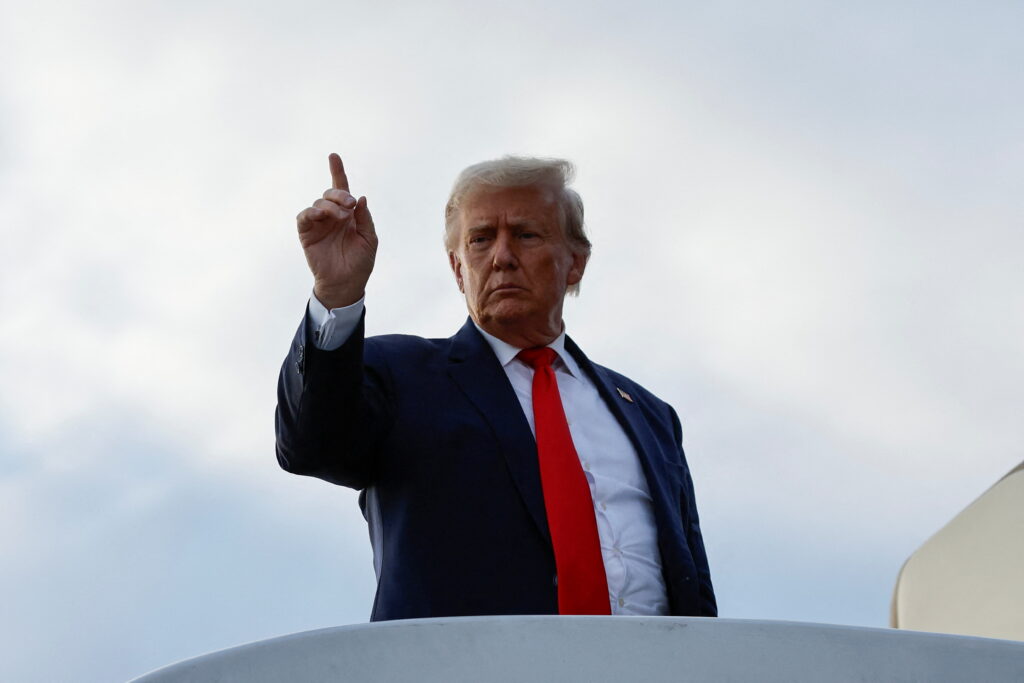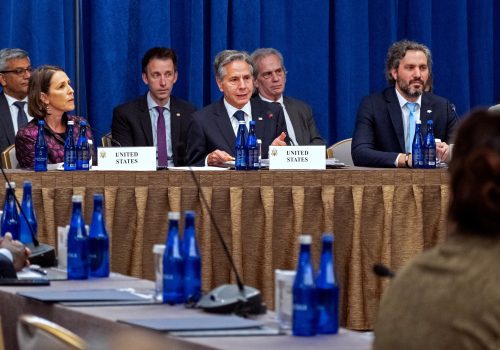Officially launched on the sidelines of the United Nations General Assembly in 2023, the Partnership for Atlantic Cooperation—also known as the PAC or Atlantic Partnership—was intended to spearhead the Biden administration’s long-term engagement model with the wider Atlantic community. Initially presented as a first-of-its-kind, state-endorsed forum for the Atlantic region, the PAC was heralded by US Secretary of State Antony Blinken as the primary vehicle through which more than three dozen coastal Atlantic nations could convene. Together, Blinken explained, they would share in their commitment to a more “peaceful, stable, prosperous, open, safe, [and] cooperative Atlantic region and to conserve a healthy, sustainable, and resilient resource for generations to come.”
There are two issues with the PAC at present. The first is uncertainty about what it is. So far, the PAC has made modest progress by launching several key initiatives and workshops including the three-day “4TheAtlantic” incubator workshop and Marine Spatial Planning Technical Assistance program. And while much has been written about the pressing need for international cooperation and coordination to solve the myriad “security challenges that Atlantic nations collectively face,” the underlying reality is that the PAC has been so far a mostly US-led and funded forum designed to promote and coordinate the furtherance of primarily US interests throughout the region.
The second issue is uncertainty about what PAC will be. In late October, Ambassador Jessica Lapenn, the US senior coordinator for Atlantic cooperation who had been a driving force in the PAC, retired from the US State Department. Moreover, this month US President-elect Donald Trump will enter office looking to distance himself from his predecessor’s policies. As a result, the future of the PAC remains as uncertain today as at any point in its short history.
However, Trump’s second term need not spell the end of the PAC. But if it is to persist as a primary venue for pan-Atlantic coordination and dialogue, it will need to reshape its overall mission focus and adopt a more Trumpian approach to its partnership arrangements. It can start by being clear about what is in it for those who have already signed on the dotted line.
For some member countries, that may mean dropping the partnership altogether, and so be it. If the PAC is to survive, it must achieve a level of relevancy to its main benefactor by eschewing the costly concessions made by the Biden administration’s negotiators in 2023, including the absence of hard security commitments and a misplaced focus on ancillary cooperation areas, such as scientific collaboration and the protection and restoration of coastal ecosystems.
In turn, the United States should resist the temptation to lead from behind. Instead, the United States must acknowledge that the PAC is a US-led and funded organization whose fate will be determined by its ability to deliver value to the United States early on during the incoming Trump administration. Only after passing this test will the PAC be able to provide benefits to the broader Atlantic region in the long term.
A future-proofed PAC
So, what could a renewed and reimagined PAC look like under Trump?
First, it must seek to reorient and align its principal activities with issues that are known to be at the top of the incoming Trump administration’s foreign policy agenda. This translates into a strong focus on countering Chinese and Russian malign influence throughout the region, and into ensuring the continued and uninhibited flow of goods, data, and financial services across one of the world’s most trafficked seaways.
For the PAC’s African members, that means anchoring their demands of the PAC to specific causes, such as countering Chinese illegal fisheries and limiting extra-regional deep-sea mining operations along the coast of West Africa. In contrast, South American members could find success if they lean on the PAC for assistance in reducing their dependence on China’s Belt and Road Initiative for funding critical minerals projects. In much the same vein, its European members might also seek greater military and maritime domain awareness assistance to counter Russia’s increasingly covert operations in the Arctic.
None of these options are mutually exclusive or exhaustive. But they serve as examples of how members of the PAC, starting with the United States, should not be afraid to seek out areas of collaboration that were previously considered off the table, including maritime security cooperation agreements and the prospects of greater economic integration of their markets.
All told, the future of the PAC will be decided not on the sidelines of the next United Nations General Assembly. Instead, it will likely be decided in Trump’s first one hundred days in office. As Daniel Hamilton and Bruce Jones from the Brookings Institution astutely laid out in September 2023, US policy advisors should accordingly refocus the PAC’s energies on securing the freedom of passage on the seas, upholding nations’ sovereignty, and combating extra-regional actors’ malign influence and operations in the region. All other policy areas, such as the development of the blue ocean economy and marine ecosystem protection, should be considered second-order priorities in this reimagined and more focused Partnership for Atlantic Cooperation.
Christian Bjørn Følsgaard is a senior advisor to the Atlantic Council’s GeoStrategy Initiative within the Scowcroft Center for Strategy and Security focused on supply chain resilience, security, and diplomacy.
Further reading
Wed, Sep 20, 2023
Does the new Partnership for Atlantic Cooperation mark a sea change in transatlantic relations?
New Atlanticist By
A newly announced group of thirty-two countries aims for further collaboration on economic development, environmental protection, and maritime issues such as illegal fishing.
Mon, Oct 7, 2024
Realizing a bolder transatlantic agenda for cooperation with Africa
Report By Rama Yade
Recent initiatives could be a beginning in the revitalization of cooperation between the United States and the European Union in Africa.
Mon, Oct 7, 2024
Foreword: A new agenda for the next four years of US-EU relations
Report By Daniel Fried, Jörn Fleck
The transatlantic partnership, powered by the US-EU relationship, is a geopolitical necessity. From the other side of the world to each other’s backyards and into cyberspace, Washington and Brussels need each other.
Image: Former US President and Republican presidential candidate Donald Trump raises a finger as he boards his plane to depart from Eastern Iowa Airport after campaigning in Cedar Rapids, Iowa, U.S. October 7, 2023. REUTERS/Jonathan Ernst



